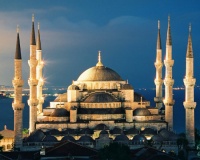Ayasofya Muzesi (537 AD)
The historical Architectural Wonder of Turkey
The Hagia Sophia is a prime example of cultural diplomacy in monument form, both in terms of the nature of the building itself, and location, through history. The monument as it stands today was built as a cathedral by the Byzantine empire in 537, but transformed in to a mosque under Ottoman rule in 1453, having transferred from Eastern Orthodox status to Roman Catholic and back again beforehand. In 1935 - by the order of Atatürk, “Father of Turks” - Hagia Sophia was secularised and converted into a museum, which it remains to this day. Its diverse religious history means that this grand and beautiful monument holds great importance for people from a range of cultural backgrounds, in addition to bringing people together through its sheer aesthetic presence. Furthermore Constantinople, later Istanbul, was extremely significant for cultural diversity, particularly in the Middle Ages. Positioned geographically somewhere between Europe and the Middle East, throughout history it has been an epicentre for cultural diversity, through trade, religion and the arts. Hagia Sophia reflects this diversity, and stands as an important cultural symbol for many, particularly in its current museum form.
